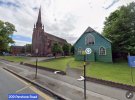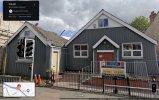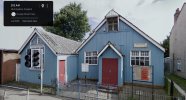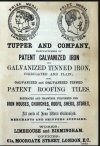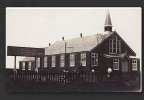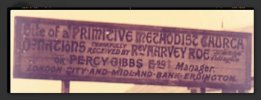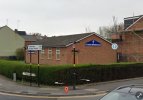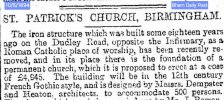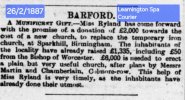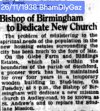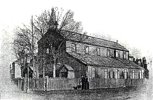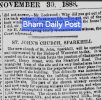I've delved into the British History Online site to extract out any info about possible buildings of the type covered by this thread. Some are corrugated iron, others are wooden structures. Where relevant I've included some of the details of later places of worship to show the link with the earlier temporary buildings.
Baptists
Pershore Road, Selly Park chapel, completed in 1877, cost £3,400 (W. Middlemore subscribed £2,600). 1892, provided 400 sittings. Services previously held in Dog Pool Chapel, a wooden mission hall erected in 1867 in St. Stephens Road by members of Bradford Street Circus Chapel. Sunday afternoon attendance in 1892 was 90. Membership, 228 in 1938, fell in 1956 to 82.
Victoria Road, Handsworth chapel, opened as a mission of Christ Church, Victoria Road, in 1885. Originally cottage meetings held at Mr Page's house. An iron sheeting building costing £240, sittings for 200. Sunday evening congregation in 1892 was 71.
Church Road, Yardley mission, a wooden building erected in 1873 by William Morgan of Stechford. In 1875 Warwick Road church took over. Permanent church built 1879, sittings for 160. Congregation of 146. Church became independent of Warwick Road in 1882. Membership in 1957 was 26.
Dartmouth Road, Bournbrook church hall, seating 350, built in 1932. Originally formed in 1894 which by 1902 held services in a corrugated iron building, 30 members. 1902 Darrtmouth Road was a mission of Francis Road. Membership in 1957 was 21.
Congregationalist
Stratford Road chapel began in 1901 as an 'iron room', serving a large new housing estate. Carrs Lane chapel provided the mission room, and the Stoney Lane and Warwick Road churches were initially responsible for supplying ministers. The first permanent chapel completed in 1934. W. H. Bidlake design built on basilican plan, with a wide nave. Sittings for 377. Constructed of brick and stone, costing £10,000. Membership in 1957 was 192.
Friends Meeting
Conybeare Street mission hall, a corrugated iron structure seating 50, was in use in c. 1884. Replaced in 1886 by new premises in Upper Highgate Street
Dawlish Road mission hall, a corrugated iron structure seating 150, opened in 1909, and may have replaced a meeting in Tiverton Road, registered for worship in 1900. The hall was closed in 1938.
Hay Green Lane mission hall, a corrugated iron building seating 100, used for Friends' meeting from 1903. Closed in 1940, and taken down.
Holly Avenue, Dogpool Hall, a corrugated iron building seating 150, was registered for public worship in 1906. Closed in 1939, suffered bomb damage in WW2 and dismantled.
Raddlebarn Lane mission hall (former building Friends Hall, Selly Hill) a corrugated iron building seating 150, opened in 1922 - preceded by another hall on the same site by Edward Cadbury 1903,- originally known as Friends Hall, Selly Hill. Destroyed by fire in 1916. During the intervening period the congregation met at Raddlebarn Lane Council School. Hall was closed 1950, then used by Birmingham corporation for educational purposes.
Station Road, Northfield mission hall, a corrugated iron building seating 100, opened in 1909. Preceded by a meeting-room in 1906. Taken over by the Brethren in 1943.
Methodists
Addison Road, King's Heath chapel, a wooden building seating 150, for United Methodists in 1927. There was a Bible Christian chapel on the site in 1908. Membership in 1932 was 54.
Bolton Road mission hall, a corrugated iron building used by the Wesleyans, open in 1908. In 1914 it was conducted by Handsworth Theological College. Building was sold in 1921 for £550.
Brays Road, Sheldon chapel, a wooden building formerly used by the Presbyterians, was re-opened by the Methodists in 1952.
Cartland Road, Stirchley chapel, a corrugated iron building, sittings for 160, erected by the Primitive Methodists in 1906, serving a congregation from cottage meetings. The first Stirchley Primitive Methodist meetings were in an old theatre. 1932 membership was 22.
Coventry Road, Hay Mills chapel opened by Wesleyans in 1929, cost £4,896. Built of brick for 300 seats, 2 ancillary rooms and school hall. Methodist worship in Hay Mills began before 1873, when a mission hall, in the Long Causeway, Coventry Road, was registered for public worship. Hall provided 120 sittings, sold shortly before 1897 for £425. Temporary accommodation obtained in an old iron building in bad repair 1929, seating 200. Congregation: 125 in 1892, 150 in 1929. Membership in 1932 was 124.
Dudley Road Trinity Chapel, a brick building for 500, 8 ancillary rooms, opened by Methodist New Connexion 1903. Fiirst chapel, opened in 1862, in Heath Street, Winson Green.1889 this was abandoned for a school-chapel in Dudley Road, where in 1892 a corrugated iron chapel was erected seating 350. Sunday evening attendance was 240. Membership was 47 in 1889; 14 in 1932.
Kings Norton Primitive Methodist chapel in 19th century on corner of Redditch Road and Masshouse Lane. Camp meetings held on the Green. 1916 a new corrugated iron building erected behind post office, sittings for 120. Sunday evening attendance 1892 was 37 Membership in 1932 18. Chapel sold in 1948.
Vicarage Road, Hazelwell chapel opened by Wesleyans in 1910, cost £2,414. Congregation previously met in a wooden mission hall, seating 100, built on rented land. New chapel, seating 262, (by E. and J. Harper) built of brindled brick with stone dressings. 1940 it comprised a main hall and 6 other rooms, 2 of which were school halls. Membership 1932 was 66.
Warwick Road, Sparkhill chapel opened by Wesleyans 1892, cost £6,180. A brick building, sittings for 750, (designers Hall and Son) 1940 comprised a main hall and 17 other rooms, one of which a school hall. Severely bomb damaged in WW2, subsequently rebuilt for £33,643. Originated in 1872, meetings, led by Bradford Street members, held at a house in Warwick Road, Greet. 1880 a wooden mission hall, seating 100, costing about £100, opened in Mountford Street. 1886 a new branch mission opened in new Stratford Road Board School. Two missions united in 1889. In 1890 wooden hall moved to Warwick Road. New chapel Sunday evening attendance of 435. Membership in 1932 was 282.
Washwood Heath Road, Ward End chapel, a corrugated iron structure seating 250, opened by Primitive Methodists in 1910, burned down in 1923, replaced by new building, registered for worship in 1925 but no longer in use in 1940. Membership in 1932 was 60.
Presbyterians
Presbyterian Church in England, United Presbyterian Church, Presbyterian Church of England) Bray's Road Sheldon Free Church, a wooden building, registered for public worship in 1940. Bought by the Methodists in 1952.

